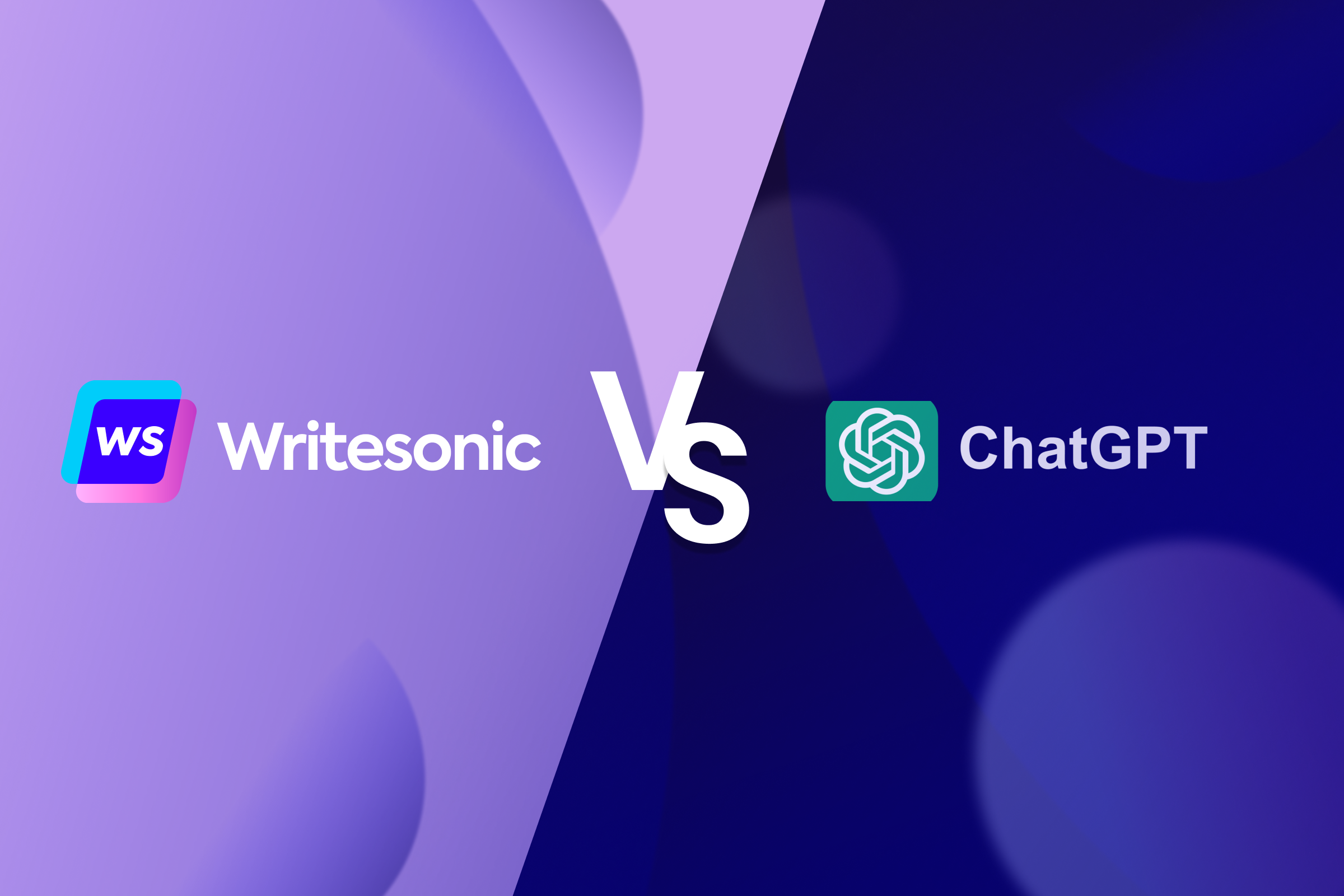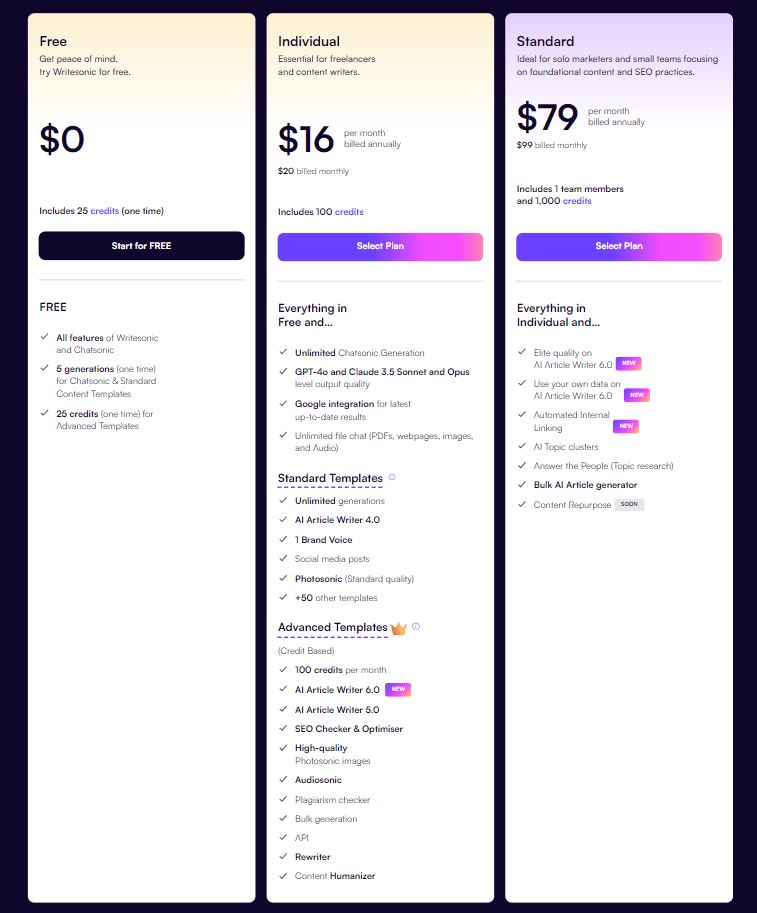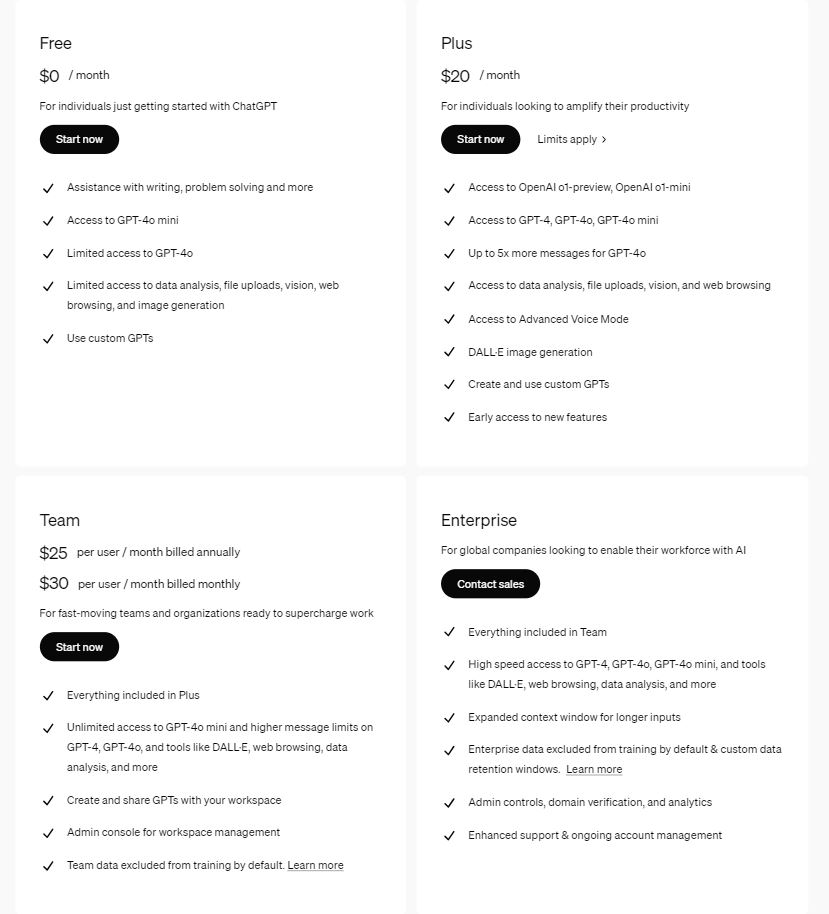Table of Contents
- Home
- »
- Content Marketing
- »
- Writesonic vs ChatGPT: The Only Comparison You Need to Read
-
Stacy Garrels
- 10 minutes read time
Writesonic vs ChatGPT: The Only Comparison You Need to Read
- Home
- »
- Content Marketing
- »
- Writesonic vs ChatGPT: The Only Comparison You Need to Read
Writesonic vs ChatGPT: The Only Comparison You Need to Read
Table of Contents

AI writing tools have transformed the content creation process bringing assembly-line type efficiency to the creative writing process. While the market is flooded with AI tools, two of the most popular options are Writesonic and ChatGPT.
Both platforms offer advanced capabilities for producing high-quality content and simplifying daily workflows. This article offers a detailed comparison of ChatGPT vs Writesonic, including pricing, features, integrations, use cases, and business needs.
By the end of our comparison review, you should have a good idea of which content generation program is right for your business needs.
What is Writesonic?

Image from Writesonic’s website
Founded in 2021, Writesonic is an AI-powered writing tool that helps content creators, marketers, and business professionals generate engaging content like blog posts, marketing emails, product descriptions, digital ads, and landing pages.
Writesonic offers a full-stack content and automation platform. Designed primarily for marketers and business owners, its easy accessibility makes it popular among agencies, enterprise marketing teams, and creative freelancers.
Offering an AI-powered chatbot, SEO tools, and real-time web search, Writesonic is far more than just a content-writing tool. Writesonic offers organizations the ability to streamline daily workflows, enhance communication, and rapidly scale their content generation.
Key features and benefits of Writesonic
- Efficient content creation at scale: From LinkedIn posts to full-length articles, Writesonic quickly delivers engaging content tailored to your needs.
- Versatile chat and automation tools: Writesonic offers a range of AI-driven tools such as Chatsonic, a real-time search-enabled ChatGPT alternative, providing users with dynamic, up-to-date content. Another tool, Botsonic, automates customer interactions, reducing the burden on support teams.
- Customized branding and tone: Writesonic enables users to create content that aligns with their brand’s voice and style guide. This ensures that every post, email, or chatbot message reflects the right tone, helping businesses maintain a consistent presence and their customers’ trust.
- SEO optimization and competitor insights: The platform offers built-in SEO tools to optimize content. The platform’s competitor analysis features recommend changes for content updates and internal linking.
- Flexible integrations and workflows: Writesonic integrates with tools like Google Docs, Slack, and Zapier, making it easy to add AI-powered workflows into existing systems. Businesses can automate repetitive tasks for greater collaboration and productivity.
- Scalable for businesses of all sizes: Whether you’re a small business, a startup, or a large enterprise, Writeesonic has flexible pricing and features to fit teams of all sizes.
What is ChatGPT?

Image from chatgpt.com. The homepage and user interface (UI) feature the same simple, stripped-down design.
ChatGPT, developed by OpenAI, is a versatile AI tool that can complete a wide range of general-purpose tasks. From crafting conversational replies to spinning new content and supporting users with everyday queries, it can assist freelancers, solopreneurs, and small businesses looking to cost-effectively streamline their operations.
With built-in flexibility, ChatGPT can also scale to meet the needs of larger organizations by handling complex workflows through advanced AI integrations.
Since its launch in November 2022, ChatGPT quickly became one of the most well-known AI tools on the market. It achieved 1 million users within five days and reached 100 million active monthly users within two months.
Many users may have experienced early versions of ChatGPT and missed the significant improvements made along the way. OpenAI has continuously enhanced the platform’s ease of use and functionality, ensuring it stays effective and at the forefront of advancements in AI and natural language processing (NLP).
Key features and benefits of ChatGPT
- Rapid content production: ChatGPT’s popularity was driven by the fact that it allows users to generate everything from social media posts, product descriptions, and emails to customer service replies and AI-generated visuals (via DALL-E 3). ChatGPT ensures that users deliver polished, engaging content across platforms with minimal effort.
- Seamless conversational interactions: ChatGPT can handle user inputs and customer queries in real-time, providing personalized recommendations, troubleshooting solutions, or automated responses—boosting customer satisfaction and operational efficiency.
- Flexible pricing to suit any need: Users can start with the free plan for basic features, while premium tiers unlock advanced capabilities like GPT-4 and DALL-E 3, ensuring scalability for individuals and businesses alike.
- Easy API integrations: ChatGPT connects smoothly with platforms like Zoho, HubSpot, and Salesforce to enhance productivity. It also integrates with project management tools, automating workflows, data entry, and other repetitive tasks to streamline business operations.
- Scalable for small and large operations: Whether you’re a small business owner or part of a larger organization, ChatGPT’s range of tools adapts to the needs of businesses of all sizes, making it effective for both everyday tasks and complex workflows.
Capabilities: What can Writesonic and ChatGPT do?
While both platforms can be part of an organization’s content workflow, each tool has its own strengths that make it better suited for specific use cases.
Writesonic
- Blog post writing: With Writesonic, users can quickly generate SEO-friendly blog articles for audience engagement and discoverability in search engines. Writesonic ‘s AI-powered writing assistant provides outlines, optimized drafts, and SEO meta tags.
- SEO automation: Users have the ability to landing pages and optimize website content with real-time search data and automated internal linking.
- AI chatbots: Botsonic enables businesses to automate up to 70% of customer service queries, with seamless handoffs to human agents for more complex issues. This reduces response times while maintaining high customer satisfaction.
- Brand voice customization: Users can ensure that all content aligns with their company’s unique tone and style.
- Multilingual support: Organizations can expand their market reach with content generation and AI task assistance in over 50 languages.
- E-commerce tools: Writesonic allows users to generate SEO-friendly product descriptions, enhance shopping experiences with personalized recommendations, and even analyze customer behavior (conversion funnels) and make suggestions to improve conversion rates.
ChatGPT
- Conversational AI: Users can leverage ChatGPT’s conversational AI capabilities for customer support bots on platforms like WhatsApp, Slack, and Facebook Messenger.
- Content ideation and creation: Content teams have the ability to generate outlines, blog drafts, email campaigns, and product descriptions. ChatGPT serves as a starting point to accelerate the creative process for marketers and writers.
- DALL-E image generation: Companies can ensure consistent branding by generating custom visuals for social media, landing pages, and marketing campaigns directly in the ChatGPT platform, making it easy to create visual content alongside text.
- Voice interactions: ChatGPT’s advanced features support multimodal engagements, such as voice-activated apps to seamlessly connect AI tasks to smart devices.
- API integrations: OpenAI’s wide range of integrations allow users to integrate ChatGPT within CRM systems, project management tools, collaboration apps, and e-commerce websites for smoother operations and collaboration. Companies can also connect ChatGPT with internal databases to offer employees quick access to knowledge bases, wikis, FAQs, and training materials.
- Multilingual capabilities: Companies can engage global audiences by generating content in 50+ languages. ChatGPT can also assist in translation and localization tasks, making it useful for international businesses.
- Creative collaboration: ChatGPT serves as a brainstorming partner to generate ideas and solutions for both creative and technical tasks.
Integrations: Which platform fits best into your workflow?
Writesonic integrations
With Writesonic’s Zapier integration, it can support over 5,000 apps, including:
- Communication tools: WhatsApp, Slack, Facebook Messenger, Telegram, Microsoft Teams
- Marketing automation: Google Tag Manager, Mailchimp, ActiveCampaign, HubSpot Marketing Hub, Klaviyo
- CRM platforms: HubSpot, Salesforce, Zoho, Pipedrive, Monday.com
- Project management apps: Notion, Trello, Google Drive, Asana, ClickUp, Basecamp
ChatGPT integrations
- API connections for custom implementations: ChatGPT can be embedded into apps and websites using RESTful APIs, WebSocket connections, or JavaScript frameworks like React, Angular, and Vue.js.
- Email and communication platforms: Communication and workflows can be streamlined by integrating ChatGPT with tools like Microsoft Outlook and Gmail.
- Productivity tools: ChatGPT integrates seamlessly with Google Sheets and Microsoft Excel to generate reports and analyze structured data efficiently.
- Automation limitations: ChatGPT lacks native workflow automation and relies on third-party plugins or APIs to handle more complex tasks.
- Third-party tools for advanced workflows: To manage multi-step processes or task automation, businesses often combine ChatGPT with solutions like Zapier or develop custom integrations to meet their needs.
Pricing comparison: Writesonic vs ChatGPT
Writesonic pricing

- Free Plan: Access to ChatSonic and Writesonic with limited templates.
- Individual Plan – $20/month (or $16/month with annual billing)
Includes unlimited ChatSonic use (GPT-4 and Claude 3.5), Google search integration, AI tools for file chat, social media templates, and SEO tools (plagiarism checker, optimizer). - Standard Plan – $99/month ($79/month with annual billing)
Builds on the Individual Plan with AI Article Writer 6.0, topic clustering, bulk article generation, and smart internal linking. - Professional Plan – $249/month ($199/month with annual billing)
Adds team collaboration for up to 3 users, personalized onboarding, and competitor benchmarking. - Advanced Plan – $499/month ($399/month with annual billing)
Includes enhanced team features (up to 5 users), Google integrations, and priority support. - Enterprise Plan – Starting at $9,999/year
Offers unlimited access, custom workflows, SSO login, analytics, and a dedicated success manager.
ChatGPT pricing

- Free Plan: Basic access to GPT-4o Mini for simple tasks.
- Plus Plan: $20/month with access to GPT-4 Turbo and image generation tools.
- Team Plan: $30/user/month annually (or $25/month with annual billing) with enhanced admin tools.
- Enterprise Plan: Custom pricing for high-volume users and advanced integrations.
Both platforms offer scalable pricing, but Writesonic’s plans focus on marketing automations, while ChatGPT’s flexible API-based pricing caters more to developers and large enterprises.
Who should use Writesonic vs ChatGPT?
Writesonic
- Marketers and small business owners:
Use Socialsonic for social media posts and Chatsonic to create SEO-driven blogs and web content. It’s ideal for scaling content production and building personal brands. - E-commerce businesses:
Enhance customer experiences with personalized product recommendations and dynamic content for individual shopper preferences. - Support teams:
Automate customer inquiries and FAQs more efficiently through Botsonic, freeing up staff time for more complex issues.
ChatGPT
- Freelancers and content creators:
Leverage ChatGPT’s free and affordable plans for quick articles, emails, and creative copy. Perfect for independent workers managing diverse projects on a budget. - Enterprises and large businesses:
Use GPT-4 Turbo for customer support chatbots, streamlining customer interactions across multiple channels. - Developers and tech teams:
Integrate ChatGPT’s APIs into websites and apps to create automated workflows and customized chat interfaces.
User reviews: What are people saying?
Writesonic reviews

Users on G2 give the platform a 4.7-star rating based on 2,000 reviews.
Users on G2 give Writesonic an average 4.7-star rating, with 87% of reviewers giving the app a perfect 5 stars.
One user writes that Writesonic is the “best AI writer I’ve used so far.” They note that they’re a professional writer and most AI tools require significant reworking “but that’s not the case with Writesonic. I started with one [article] to try the tool out, and I was extremely impressed… The cost is a downside, but you get what you pay for.”
A social media manager leaves the following review of Writesonic on G2. “You can add pictures for it to generate words [and] the layout is clean and well-organized, with clear menus and options.”
Overall, G2 reviews praise the platform for its easy set-up, intuitive user interface, and range of content creation capabilities. They do note, however, that setting up workflow automation may be difficult unless you have coding experience, and some users are unhappy with word limits and platform costs.
ChatGPT reviews

ChatGPT averages a 4.7-star rating on G2 based on feedback from over 600 users.
Users give ChatGPT an average 4.7-star rating on G2, with 85% of reviewers scoring the app a perfect 5 stars.
One user writes that ChatGPT is a “gamechanger” and appreciates “the ability it gives me to execute tasks that I don’t have experience or skills to do otherwise… It saves me money as I don’t have to outsource to third parties… I use ChatGPT on a daily basis.”
Another ChatGPT user writes that it’s “a good AI assistant tool helping you in your day-to-day life tasks” but says “sometimes ChatGPT produces confusing and made-up answers…and their code accuracy solutions still are not good.”
Overall, ChatGPT users give it solid reviews. People appreciate its versatile functionality. For basic content creation—such as essays, blog articles, landing pages, and social posts—they find ChatGPT to produce high-quality content in an easy workflow process. On the other hand, many users cite issues with content inaccuracy, conversation recall, usage limitations, and general AI constraints.
However, most reviewers do not distinguish between the free (limited) version and the more powerful paid-subscription versions with more AI capabilities like memory recall and faster, more up-to-date outputs.
Where Writesonic and ChatGPT fall short
While both platforms are solid with impressive reviews and business client rosters, they do come with some shortcomings.
Writesonic
- The subscription model, with seven different tiers, is overly complex.
- More advanced (useful) workflows often require coding skills.
- The free version is very limited and offers 25 credits (one-time) with no free reloads. That’s enough for 1-5 blog articles or other content pieces, rendering it functionally useless for businesses.
Writesonic credits are needed for “templates” or different content requests such as bulk upload or AI article writer. Templates for a new article are either 5 or 20 credits.
ChatGPT
- SEO limitations: No built-in SEO tools. External tools are required to optimize any content.
- Throttled usage: Free-tier users have limited access to ChatGPT with potential restrictions based on demand. Plus Plan users can send up to 40 messages every 3 hours on GPT-4, while Team Plan users get about 100 messages every 3 hours. Enterprise users enjoy more flexible access without strict message caps, tailored to business needs
There are issues with factual inaccuracies with both Writesonic and ChatGPT. These AI writing tools are built to offer creative writing assistance based on user prompting, not replace humans altogether. To get content outputs that are wholly accurate, relevant, and up-to-date, human collaboration and oversight are always a must, or else AI tools will write articles that “go off the rails.”
Even when the AI tool can access the latest Google Search results, the information pulled in can still be dated and error-prone. Chat AI technologies are not discerning about search engine results in the same way people are.
Blend AI superpower with human expertise: Wordbrew
While Writesonic and ChatGPT are powerful, they lack fresh human insight. They regurgitate existing content off the web to generate blog posts, with finished pieces that lack authenticity and originality.
Wordbrew takes content creation to the next level by combining AI speed with real human insights and expertise.
Wordbrew features:
- Collaborative workflows: Wordbrew allows users to request insights from both internal experts and Wordbrew’s community of 400+ subject matter experts in a range of industries from finance and SaaS to construction and legal. These experts provide insights to make the content truly unique and AI refines the content based on your brand data to ensure consistency.
- Flexible templates: Create branded content for blogs, email campaigns, ads, webpages, social media posts, and more for smoother content operations.
- Integrations: Wordbrew integrates seamlessly with a range of tools and platforms with many upcoming integrations including Notion, Google Drive, and Slack to improve collaboration and shorten content production lifecycles.
Finding the right AI writing tool for you
Choosing between Writesonic and ChatGPT comes down to your specific user needs. Writesonic excels in SEO-driven content and creative workflow automation, while ChatGPT offers more flexibility through APIs and advanced AI models.
However, if you’re looking for a blend of AI and human insights without the hallucinations, Wordbrew ensures accurate, engaging, and high-impact content that resonates with your audience.
In the end, the best AI writing tool isn’t just the one with the most features or the quickest factory-floor speed: It’s finding the one that aligns with your business goals and drives traffic to your website. With almost any AI tool, it can be done quickly and cheaply. With the right AI tool, it can be done effectively, so it amplifies your search presence and brand reputation for authenticity and expertise.
Want to make content creation fast, easier, and more impactful—that doesn’t sound like AI fluff? Try Wordbrew! We blend AI speed with human insights for fresh, crisp content that connects with readers. Get started now and see the effortless difference firsthand.